

Kaizena · Give Great Feedback. What if you marked every book, every lesson. ‘God save thee, ancient Mariner!
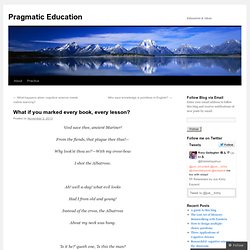
From the fiends, that plague thee thus! — Why look’st thou so?’ —With my cross-bow I shot the Albatross. Ah! Had I from old and young! Instead of the cross, the Albatross About my neck was hung. ‘Is it he?’ By him who died on cross, With his cruel bow he laid full low The harmless Albatross. The self-same moment I could pray; And from my neck so free The Albatross fell off, and sank Like lead into the sea. Marking is an albatross What makes education different in the age of digital reproduction?
The marking paradox So here is the marking paradox: although it’s one of the most important things for pupils, it’s one of the most difficult things for teachers. Why use multiple-choice questions. Blind justice: rebalancing the weighing scales There is some scepticism as to whether multiple-choice questions are useful.
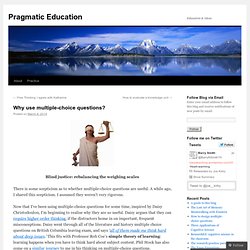
A while ago, I shared this scepticism. I assumed they weren’t very rigorous. Now that I’ve been using multiple-choice questions for some time, inspired by Daisy Christodoulou, I’m beginning to realise why they are so useful. Daisy argues that they can require higher order thinking, if the distractors home in on important, frequent misconceptions. Here are some of the reasons why I think they can benefit teaching: 1. 2. 3. Let’s take each in turn. 1. Reliability is best understood with the weighing scale analogy: the chance that if the object has not changed weight, the weighing scale will tell us the same weight. Extended essays are easy to set but hard to assess reliably. Multiple-choice questions are hard to set but are always reliable to assess. Paul Bambrick Santoyo makes the following case: ▪ In an open-ended question, the rubric defines the rigour. Assessment and Marking. Making Feedback Count: “Close the Gap” Recently I have been looking again at the issue of marking.
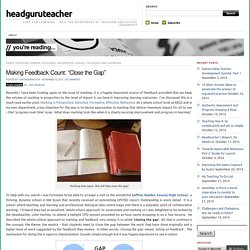
It is a hugely important source of feedback provided that we keep the volume of marking in proportion to the level of impact it can have in improving learning outcomes. I’ve discussed this in a much-read earlier post: Marking in Perspective: Selective, Formative, Effective, Reflective. At a whole school level at KEGS and in my own department, a key objective for the year is to devise approaches to marking that deliver maximum impact for all to see – that ‘progress over time’ issue.
What if Feedback wasn’t all it was cracked up to be. So, what if Feedback isn’t all it’s cracked up to be?
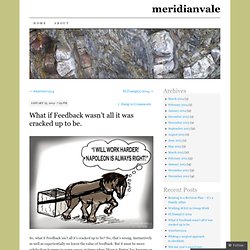
No, that’s wrong. Instinctively as well as experientially we know the value of feedback. But it must be more subtle than it seems to come across at times when ‘More is Better’ has become an imperative leading to a feverish enthusiasm for work & feedback scrutinies and the associated rabid marking schedule. Maybe a question for its twin – marking. What if Marking doesn’t satisfy the expectations made of it? Why the recent (in the last two years, anyway) upscaling of regular marking to the ark of sanctity? How I cope with marking. Marking kills teachers.
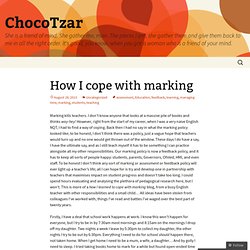
I don’t know anyone that looks at a massive pile of books and thinks way-hey! However, right from the start of my career, when I was a very naive English NQT, I had to find a way of coping. Back then I had no say in what the marking policy looked like; to be honest, I don’t think there was a policy, just a vague hope that teachers would turn up and no one would get thrown out of the window. These days I do have a say, I have the ultimate say, and as I still teach myself it has to be something I can practice alongside all my other responsibilities. Our marking policy is now a feedback policy, and it has to keep all sorts of people happy: students, parents, Governors, Ofsted, HMI, and even staff. Effective Marking. WHY BOTHER?
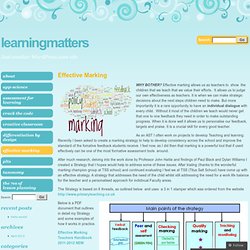
Effective marking allows us as teachers to show the children that we teach that we value their efforts. It allows us to judge our own effectiveness as teachers. It is when we can make strategic decisions about the next steps children need to make. Marking: minimum effort for maximum pleasure. This is my eighth year as a secondary English teacher.
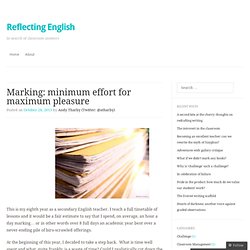
I teach a full timetable of lessons and it would be a fair estimate to say that I spend, on average, an hour a day marking… or in other words over 8 full days an academic year bent over a never-ending pile of biro-scrawled offerings. At the beginning of this year, I decided to take a step back. What is time well spent and what, quite frankly, is a waste of time?
Could I realistically cut down the marking hours, yet continue to have a positive impact on my students? Or even better: could I claw back precious time, yet have an even greater impact on student progress than I once did. With this in mind, I have devised a strategy of using symbols, rather than laboriously writing out repeated comments in the students’ books. I had been marking a class set of Y10 essays on John Steinbeck’s Depression-era novella Of Mice and Men. Students have to read their comments as well as their grade. So where next? Like this: Like Loading... What if you marked every book, every lesson.